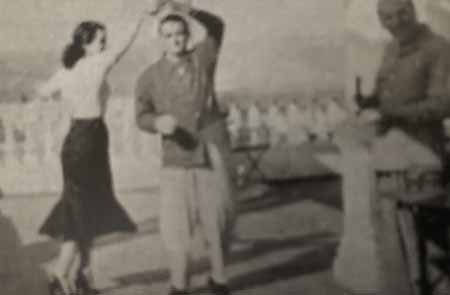This is transcribed verbatim from an article that appeared 1947 in the Star Program (provided by Keith Morris). Video material: courtesy of Paul Harris
Three weeks in Cuba By Monsieur Pierre PDF of the original vintage manuscript
London, Friday, December 19th – New York, the next morning – New York- Miami overnight the following Sunday – Miami-Cuba (a matter of 80 minutes) on the Tuesday! This is how one travels these modernistic days. This is how it happened that one Christmas Eve I was dancing in Havana in my quest to discover the latest developments of the most modernistic of all dances –the Cuban Rumba.
There are very few Dancing Schools in Havana
I made my headquarters during my stay in Havana at the best one: the Sydney Trott Dance Studio in the delightful “Bajo la Luna” (Underneath the moon) Patio (Spanish Courtyard) of the Hotel National de Cuba, Havana Millionaires’ Hotel.
Every year the Havana Municipal Council organizes a big Rumba Contest; many thousands of people watch the contest. I was fortunate enough to have lessons every afternoon with the 1947 Rumba Champion and to practice every night with his partner.
The Ballroom Rumba in Cuba is known as the “Son”. The “Son”, according to the tempo of the music is divided into “Danzon” and “Bolero” (slow tempo) and “Guaracha” (quicker tempo). The name of “Rumba” exclusively applies to the exhibition version of this dance.
There are many night clubs in Havana,
but the best dancing is seen in the “Academias” which are the equivalent of our “Palais” and are usually smaller. I discovered that visitors to Cuba usually dance the style of Ballroom Rumba that we do here, the Cubans call this the “American System”.
Systema Cubano
The Cubans themselves dance the “Sistema Cubano” which I have brought back with me and which is the most fascinating Ballroom Dance I have ever come across. The “Systema Cubano” is, of course, in many ways similar to our “American System” but the rhythm is different (it is danced on the “off” beat). Some of the movements somewhere resemble the “Jive” but the latter dance is unknown in the Cuban Ballrooms. This point should be remembered by those who like to imagine that the Rumba has been influenced by the Jive. The only form of the Fox Trot danced in Cuba is a sort of “Rhythm Dancing” similar to ours. The Paso Doble is played extensively and danced in a very simple way. The Dance Programmes include about 80 per cent of Cuban Music. I was able to obtain most interesting and useful information on how Rumba Competitions are judged in Cuba and the United States.
The judging
Marking is done on the “Olympic Point System”, judges concentrating on important points: Rhythm, Position, Authenticity, Originality, etc. Each point is marked from 2 to five: 2-poor, 3-fair,4-good, 5-exellent. The Cuban judges attach the highest importance to Style and Deportment and both the Cuban and American judges agree that the couples who indulge in exhibitionistic or suggestive feats should be marked down. This, of course, does not mean that the competitors’ dancing should be dull or lifeless. On the contrary the rhythm of the Cuban ballroom experts is terrific and their variations most attractive. I was thrilled by their demonstrations. But they are always perfectly natural and their balance and control are superb!
I am convinced the Rumba in this Country will succeed
I have had the honour to be asked by the Organisers of the “Star” Ballroom Championship to be their adviser in the Rumba Contests. The Ballroom Rumba in South America is immensely popular because it is kept as a ballroom dance. I have made every effort to make this point clear to everybody concerned with the “Star” Rumba Championship. If this principIe is followed I am convinced the Rumba in this Country will succeed not only as a Competition but also as a Standard Ballroom Dance.
Pierre Jean Phillip Zurcher Margolie (Monsieur Pierre)












Oh three weeks in cuba! The name of the article is already a joke. People living in this rich countries for twenty years would have trouble to translate the feeling of their music and the matrix of their dance. Three weeks in cuba: seems like the title of a hollywood movie, and represent the way ballroom community looked at their Latin appropriations: like summer loves, a exotic piece of stereotype. What ballroom community made with Latin cultures – the racism, the fear, the conservatism – is one of the main examples of a hard and ignorant colonialism, that shows that europeans still didnt mature that side of their historic personality.
Thank you for this. It substantiates the fact that the mambo was created in Cuba. So many have asserted that it was created in New York. Yet, people were doing it there as early as 1944 as seen by teachers at the Arthur Murray Dance Studio there. It was of course during the war.
I was an Arthur Murray dance teacher from 1956-1960. Then became a professional singer/dancer with Latin shows in Vegas.
Would love to hear more. Was this an offshoot of the “Commando”.
Arthur Murray had a school there as well. We’re there many others. Tell me about the big rumba contests?
Josephine Powell, author
this is priceless footage of pierre during his first of many trips to cuba in the years 1947-63. a very experienced dance teacher, he did what the Cubans had NOT done up to that time: document the cuban SON, the queen of what are commonly called “latin” dances (actually CUBAN)… and the granddaddy of the mambo, chachacha and what is now being called and sold as “salsa”. the popularized mambo was actually a re-naming of a quick-tempo son that was called guaracha in pre-revolutionary cuba…deepest thanks pierre!